OUR BURNING PLANET: OP-ED
The artist’s way in the climate crisis
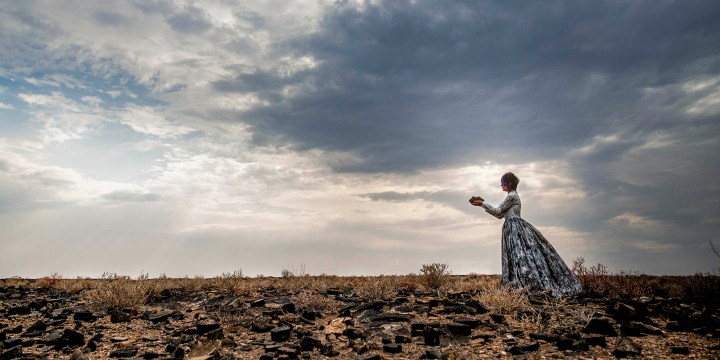
At a time of planetary emergency, artists need to be more than artisans who produce commodities to be bought and sold for audiences’ aesthetic pleasure. They need to reclaim their place as society’s primary storytellers and disrupt the cultural narrative that’s allowing predatory extraction of an exhausted and dying natural world.
It’s late, probably close to midnight, but out here in the Tankwa Karoo, there are no watches. It’s always just now-ish.
An iridescent moon tracks across the vaulted darkness, a spotlight above a stage where a rare piece of theatre is about to play out.
Six giant conical wooden spikes rear up out of the gravelly desert floor, towering over the audience, which looks like a skirt of ants spread out on the ground at a safe distance. The largest is a 10-storey colossus.
Fire will not be the towers’ destruction, explains their creator, artist Nathan Honey. Fire is their completion.
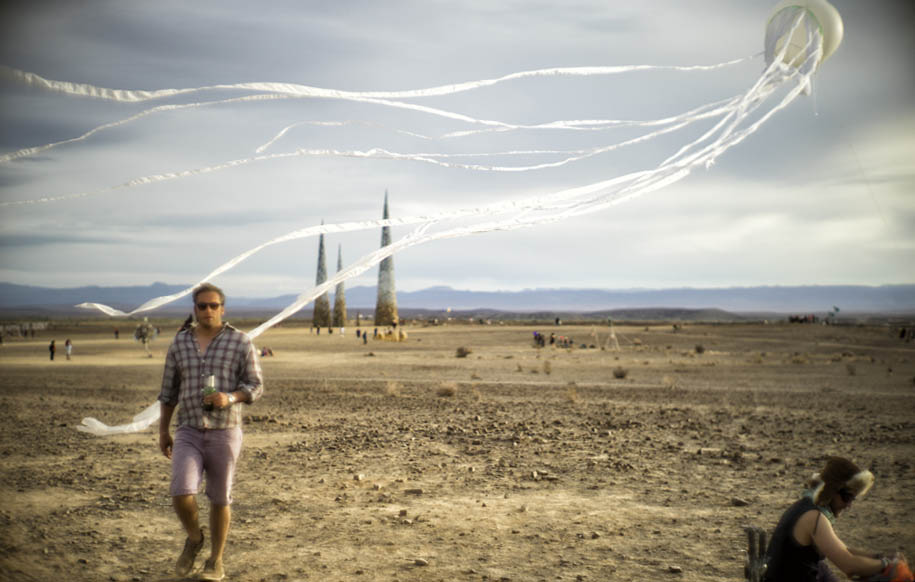
Subterrafuge, an anti-fracking protest installation which stood in the Tankwa Karoo from 2014 to 2015, speaks to the shadowing interests of the gas hunters of the corporate mining world, according to artist Nathan Honey. (Photo: Michael Groenewald)
It is the autumn of 2015 at the AfrikaBurn music-art-self-expression festival, about four hours’ drive from Cape Town. Subterrafuge, a piece of commentary on the dark arts of shale gas prospecting by Shell in the Karoo, is about to go up in flames.
In daylight, the piece blends into the stark landscape. Giant hollow cone-shaped towers, with a skin of two-toned cladding; browns at their base which merge with the gravelly pan on which they stand; melting into sky-blue at their apex. At night, lights hidden inside them cut shimmering profiles out of the dark.
The splendour of the piece is an intentional deception, says Honey. He could have made the sculpture an aggressive black or red, but he wanted it cloaked in beauty. It represents the shadowy self-serving interests of the gas hunters of the corporate mining world. Each of the towers is designed to be a violent intrusion rearing up out of the flat landscape, but he turned these hard, geometric, symbolically-violent shapes into something mesmerising.
“The colour is a reference to deceit, the kind of hiding of the truth that goes with exploitation by fossil fuel companies,” Honey explains.
The name, Subterrafuge, carries the subtext of the double-dealings of the industry: “sub”, meaning “under” or “below”; “terra”, referring to land or territory; “fuge” alluding to “expelling” or “dispelling”; “subterfuge”, the deceit used to achieve a goal.
Only about 20,000 people saw Subterrafuge in person, standing in its outdoor gallery from early 2014 until it burned in 2015, but photographs of the piece took it beyond this remote desert pan, and its fame spread. An academic wrote an anthropology paper on it. Environmentalists used it for their anti-fracking campaigns. Photographs made it into art magazines. Google Earth even captured it from space, its midmorning shadows pointing west. Yoko Ono, herself an anti-fracking activist, sent Honey an email, saying how much the piece had moved her.
When the time comes for Subterrafuge to burn, the moon is still high and the waiting crowd hums with excitement. Torch-bearers touch the ends of burning poles to the base of the largest tower, and within seconds, the flames sink their teeth into the desert-baked wood.
The inside of the biggest tower glows yellow through its porous skin as the dried kindling inside it ignites, and the crowd melts into an ecstasy of whoops and cheers.
Honey explains why this moment was a triumph: the fire was started without any accelerants. You can’t build an artwork in the Karoo that’s opposed to the fossil fuel industry, and use diesel to set it alight.
Within seconds, the flames claw their way up the inside of the highest spike, making it shimmer with a ravenous heat. Soon, each spike is vibrating as the hungry flames spread, lunging out the side of the towers as the north-westerly wind curls the flames sideways. The heat sends a dervish of mini-twisters whirling away from the singing inferno, sucking up spirals of air, dust and ash as they twirl over the desert floor. They spin, gyrate, dissolve into nothing.
The towers roar. The audience shrinks back as the smouldering air smacks them in the face.
Stage left, one tower leans a fraction, as if resting a weary hip. Then, improbably slowly, the full might of the thing arcs sideways and slams into the ground, an explosion of flame and sparks. The audience erupts. Moments later, a second cone succumbs, buckling at the knees. Then another gives way, transforming into a storm of glowing particles. Another falls. Finally, the largest, the 10-storey behemoth, gives way at the waist, toppling sideways.
All that remains of the several tons of wooden ribs and cladding that made up this soaring sculpture is the flaming trunk of the biggest tower and the fading hoots of a satiated crowd.
In the year that this piece of protest art stood in the desert, it became the emblem of a small group of activists trying to push back against the exploits of the gas mining industry. Now, finally, the last strokes of the artwork that was Subterrafuge are drawn into the night sky in a volley of heat and flames, and cheering exultation.
The ‘rangers’ appointed to keep the crowd away from the flames eventually drop the perimeter and let the theatre-goers press in. Some shed their clothes to dance, radiant-skinned in the glow, while the rest of the crowd drifts off into the night.
Just like that, Subterrafuge is transformed into nothing but embers and memory.
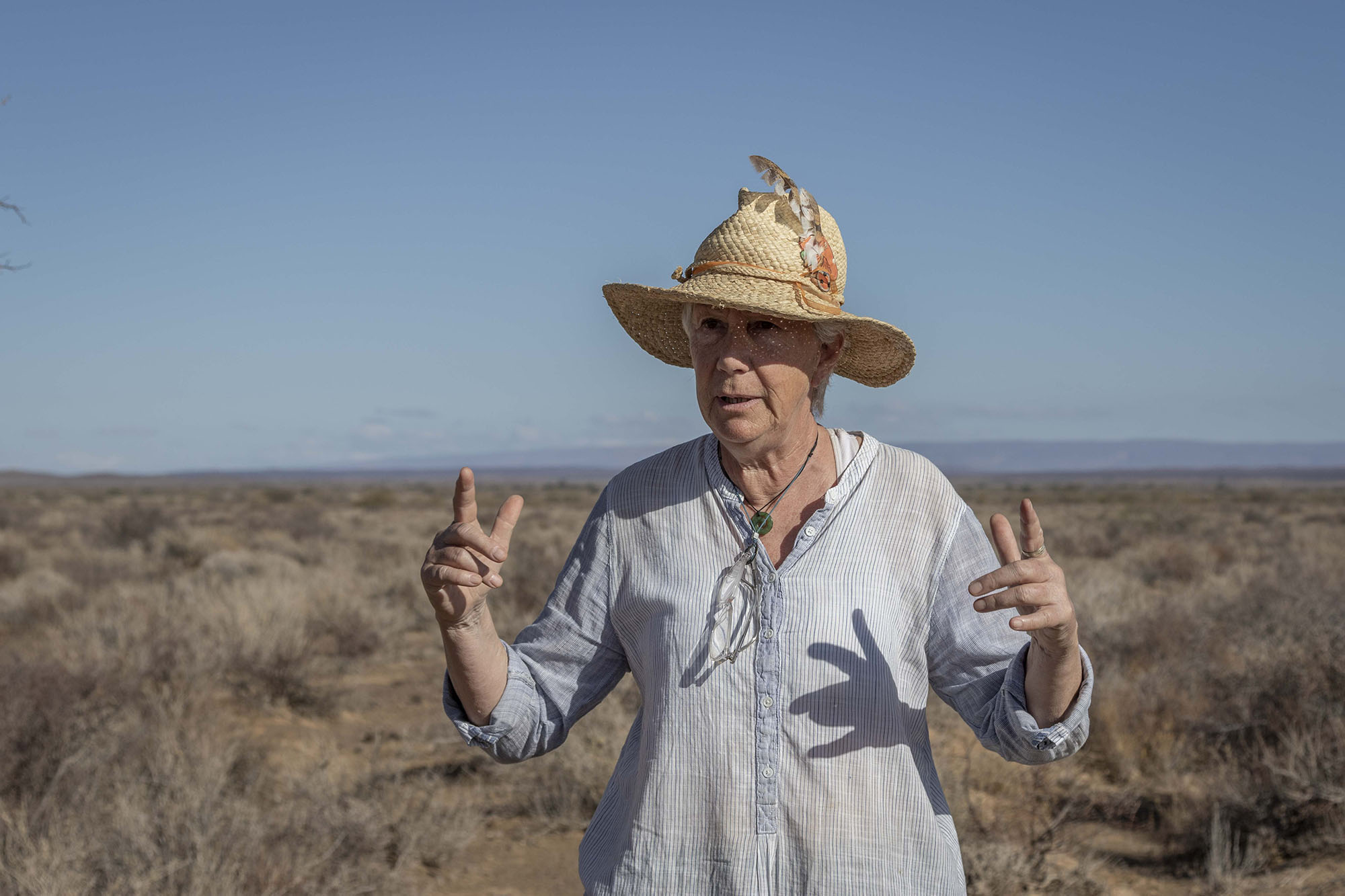
Leli Hoch (Photo: supplied)
Micro and macro: reawakening the nature-connection
Leli Hoch’s feet crunch over the desert floor, issuing the rhythmic gravelly echoes from what was once the bottom of a shallow inland sea over 260-million years ago.
“As an artist, you have to respond to this,” she says, her gaze sweeping across the rolling, seemingly barren expanse. “There is no way around it.”
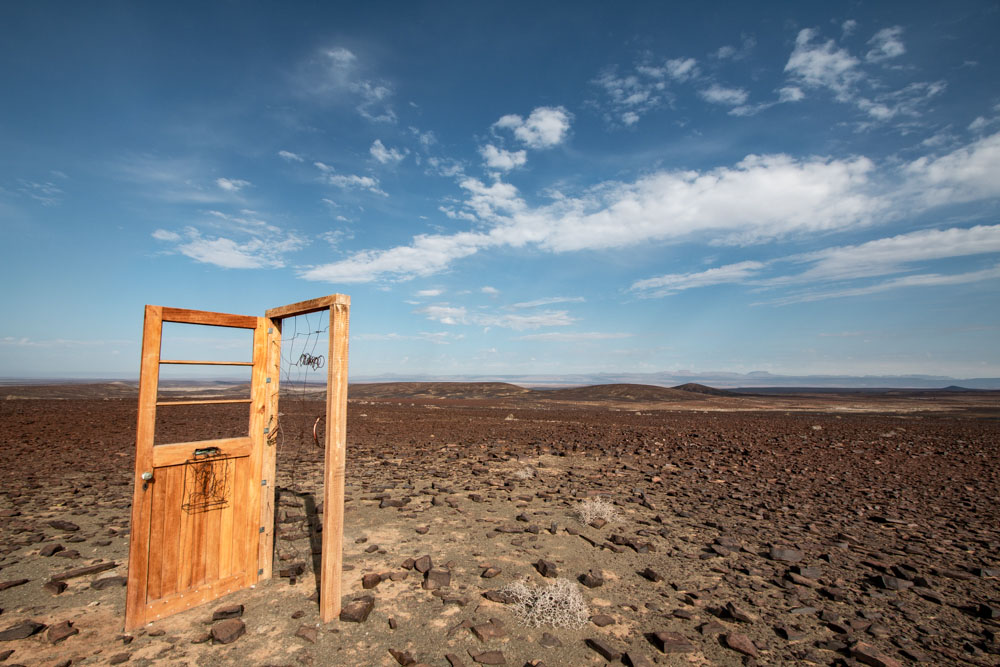
‘Obstructed Portal’ by Leli Hoch, Tankwa Artscape residency 2018, speaks to ‘our entangled minds, created by the chaotic overstimulation of our senses in urban life’. (Photo: Tankwa Artscape residency)
It’s late autumn in 2019, and the German-born land artist is walking across the same desert landscape where Subterrafuge stood a few years earlier, on a private farm bordering the Tankwa Karoo National Park.
She’s approaching an open-air installation by Overberg sculptor Niël Jonker, a piece woven into the landscape during the inaugural Tankwa Artscape artists’ residency a year earlier. “Tankwa whatwat” is ambiguous and mythical, a serpentine body of driftwood flowing up out of the ancient sea-bed and coiling through the air, a metal canine head gazing south.

Maia Lehr-Sacks’ ‘The Little Paper House’, stitched together on-site from white paper using a hand-driven sewing machine, was torn apart by the wind within 20 minutes. The destruction of the delicate shelter was a necessary part of her own process of trying to find ‘home’, she says. She found unexpected solace and comfort ‘in this deeply foreign and unfamiliar landscape’. (Photo: Tankwa Artscape residency.)
“For some, conceptual art must be a metaphor for what you want to say. It should be several levels removed from your thoughts, not a direct representation,” Hoch muses. “For others, it’s a story, and the elements of the piece should be readable. If you get the elements right as an artist you might be able to get the message through.”
In May 2019, 12 artists headed out into the desert for the second Tankwa Artscape residency, which has evolved beyond being an opportunity just for sculptors to work within the landscape to produce a wilderness-inspired art piece. Now the residency is open to any artists working in performance, sound, movement, and ephemeral art.

Dutch artists Karola Pezzaro and Aris de Bakker used an abandoned reservoir to create ‘Echo of the Desert’, an installation that blends into the Tankwa landscape using found materials. (Photo: Tankwa Artscape residency)
Some of the art pieces from the residency were installations that will stand in the landscape indefinitely. Others were created for a once-off performance and recorded for posterity. All of them used what they found in the desert to draw inspiration as well as the materials for their creations: rocks, trees, the sound of moving air, lichen, existential wonder.
But the purpose of the residency isn’t about the outcome, says Hoch, it’s about the process that the artist goes through in the 10-day immersion in this unlikely outdoor studio.
“The artist goes out there naked, without any tools or preconceived ideas, and responds to what they see and find and feel. It’s about starting to look, to see what’s there, and doing something with it,” says Hoch.
“Most will look at this and just see millions of black stones,” she says, scanning the ground at her feet, “but there’s the whole world down there. As an artist, I can do something with it. But at the same time, it raises questions about my interference with what is there. So I ask myself, do I really want to touch that stone and place it elsewhere for my art piece just because I would like to do it? Or shouldn’t I move it?”
The landscape here is confrontational, sharp-edged. There’s no running water to soften the dry stream-beds. There isn’t much vegetation to shelter under during the baking hours of the day. Plummeting nighttime temperatures seep a chill into the bone marrow. The wind can hurl through unpredictably, whipping up a blinding storm of scouring dust. But it’s also a fragile landscape. A car tyre cutting through a puddle after a rare rainstorm can leave a scar in
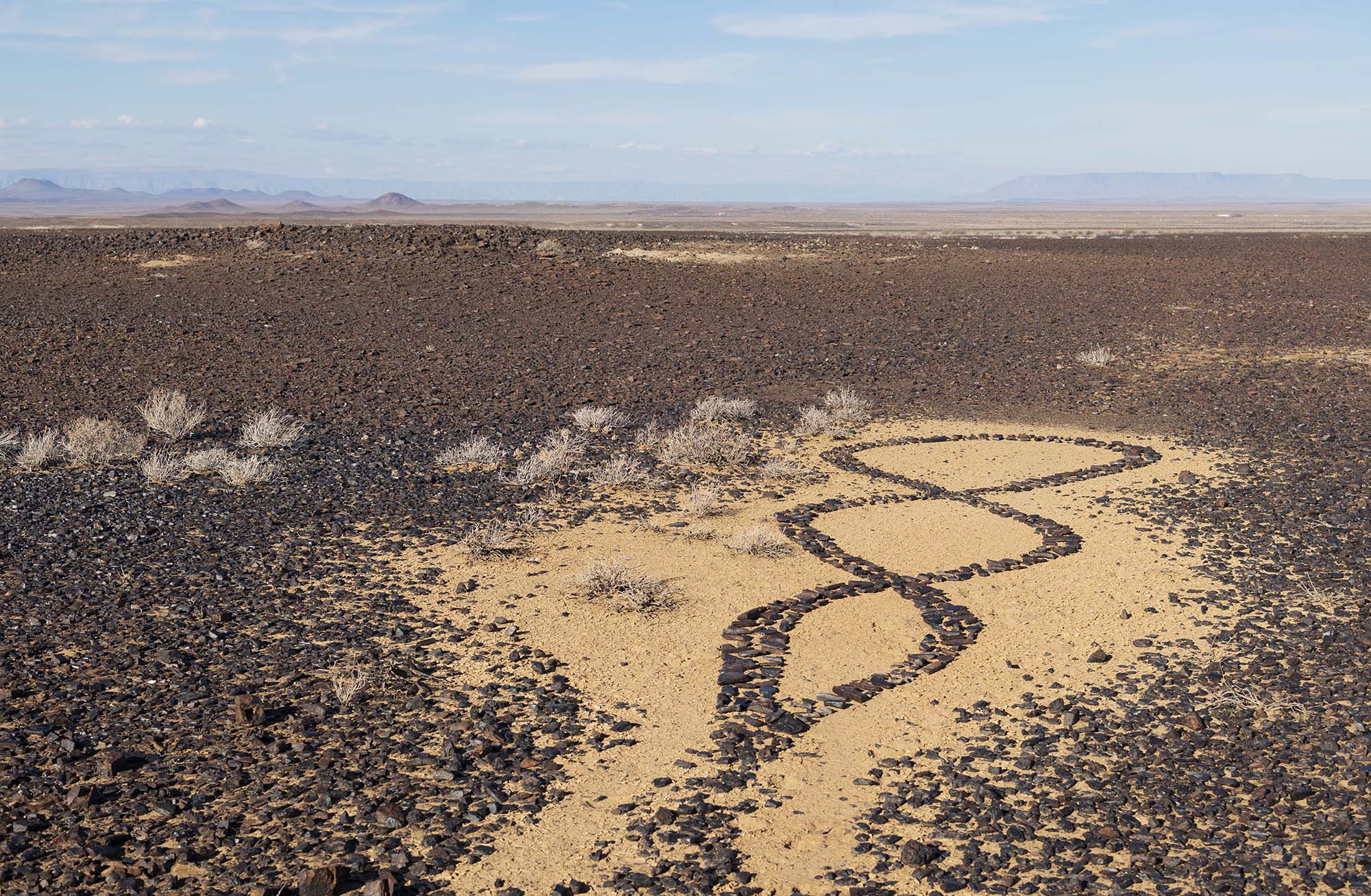
Janet Botes, ‘The Tankwa DNA’, 2019. (Photo: Tankwa Artscape residency)
the ground that could bake into the surface of the Earth for decades. Clearing stones will leave a bare patch that may never revert to its original form.
Working in an unforgiving open-air gallery, but on a canvas as delicate as this, shifts consciousness and forces the artist to interrogate how they relate to and use the materials nature gives them.
“If I do choose to move the rock, I have to go through a process in my mind. What is my intention in moving it? Is it just an egotistical thing because I want to prettify something or become a famous artist? Does it make sense in a way that can justify moving that stone?”

French-Australian sound artist Julia Drouhin captured the sound of the desert. (Photo: Tankwa Artscape residency)
Over the years, many of Hoch’s own land art has worked in the miniature: pieces with embroidered dried leaves; transitory Palaeolithic-looking patterns dotted onto the gravel using stones and sun-bleached antelope scat; lily leaves and flower petals assembled briefly on the surface of a pond and photographed, before invisible currents drift them away and return them into the cycle of life.
When Niël Jonker explains the purpose of land art, following the creation of “Tankwa Whatwat” in 2018, he says creating art in this wilderness space “reminds you of your place” in the world.
Hoch’s own path into small-scale land art started a kilometre above the ground when she was running a hot air ballooning business in Germany many years ago. Drifting high above the Earth, with the imperceptible movement of the air currents and barely a noise beyond the gas burners, “allows you to see the planet beneath you very differently”.
The experience she describes is similar to what astronauts call the “overview effect”: that moment when, from a high vantage, someone looks down over the Earth and realise that this is home. This is our only home.
“It gives you such a compassion and love for the planet,” she says.
Back down on the ground, though, crunching over rocks whose age makes her own short life seem like a flicker of nothing on the scale of deep time, her lens pulls back into the micro.
“Here, this is the planet.”
Her hands gesture to the rocks beneath her feet.
“There’s nothing in between you and it anymore. For me, this is the most basic and honest way to do art.”
Storytellers as social disruptors
Early in December 2019, the United Nations climate negotiations wrapped up another round of talks geared towards thrashing out a global policy to reduce all carbon pollution rates to a level that aims to stop Earth’s average temperature from slipping above a 1.5°C threshold in warming.
But these talks have been widely panned for their distinct lack of urgency.
Earth’s temperature is already 1°C hotter than pre-industrial levels, a warming that is activating nine natural tipping points which could trigger run-away and irreversible global heating, according to a recent article in the journal Nature. There is only 0.5°C wiggle room, before Earth’s temperature pushes through the Paris Agreement ceiling.
The “climate emergency” is finally blasting its way into the public discourse, though, and a few artists are joining the collective conversation.
Danish-Icelandic artist Olafur Eliasson has an exhibition on at the Tate Modern Gallery this year. Ice Watch is a collaboration with geologist Minik Rosing, which brings the reality of Greenland’s melting glaciers into the heart of London. They have shipped in pieces of a glacier, calved off the Greenland ice sheet and into the Nuup Kangerlua fjord, and spread these out in front of the gallery in blocks weighing between 1.5 and 5 tonnes each.
Hauling the ice this far south came at the equivalent carbon cost of flying about 52 school children round-trip to Greenland to see the glacier in person, the artist-scientist duo says. But this way, bringing the glacier to London, “hundreds of thousands of visitors … get to connect with the issue of the climate emergency” through having a “direct and tangible experience” of the reality of the melting ice.
Ice Watch moves the visual storyline away from the threadbare trope of the starving polar bear, which locks the narrative of the rapidly melting Arctic regions into one that’s limited to conservation concerns for a single, distant species that few people can relate to. The installation reminds the viewer that the frozen Arctic is the planet’s air conditioner, which impacts climate systems around the globe, and that the ice sheet is losing “around 200 to 300 billion tonnes of ice each year”, a rate that is expected to increase dramatically.
The San Francisco-based ClimateMusic Project is using the emotive power of music to help “connect people more viscerally with an issue that, for many, is too abstract for them to feel motivated to act upon”.
The project took sea level rise data from a scientific journal, converted it into graphs, and then used an algorithm to generate an audio frequency. A composer wrote a jazz and spoken-word piece, “What If We…?” based on this audio blueprint.
“This is what climate change sounds like,” said The New York Times in its review of the performance in November 2019.
Closer to home, when Cape Town’s dams were reduced to a muddy puddle after three years of the worst drought in recorded history, local singers and musicians Chuma Preshy Mgcoyi, Gershan Lombard (aka KhoisanBoy.Man), and the Jack Mantis Band collaborated on an anthem for the water crisis, aptly named “Day Zero”.
Another person to take up the mic is poet, spoken word artist, and filmmaker Richard Williams, aka Prince Ea.
“Planet Earth is 4.5-billion years old,” he rhymes in Man vs Earth.
“Let me put that in perspective for you. Mankind is about 140,000 years old. If you condensed that into 24 hours, that’s one day, then we have been here for – drum-roll, please – three seconds. Three seconds. And look at what we’ve done …”
His poem echoes the words of Richard Powers who, in his searing novel The Overstory, reminds us that in the time industrial humans have been around, we have turned half the planet into a factory farm for just one species.
Man vs Earth is a thumbnail documentary of the Sixth Mass Extinction, the brutality of industrial animal farming, en masse deforestation, and climate collapse.
“The real crisis is us,” Prince Ea weaves through his poem. “These problems are symptoms of us, byproducts of us, our inner reflection, and loss of connection.”
“We are all family, from the sunflower to the sunfish. And this is what we must recognise before it’s too late. Time is of the essence, and only together can we make it to the fourth second.”
’40 prayers for the Tankwa’
Artist Hanien Conradie’s piece from her time on the Tankwa Artscape residency earlier this year reads like the mala beads used in a Buddhist prayer chant, or a rosary: the 2.6m by 1.2m prayer rug is stitched together from rectangles of black hemp, each one covered with 108 thumbprints applied during a daily ritual.

‘40 prayers to the Tankwa’ (2019) by artist Hanien Conradie reads like Buddhist mala prayer beads. (Photo: Hanien Conradie / Tankwa Artscape residency)
Over the course of 40 days, Conradie mixed up a muddy paste from ochre soil collected near the mouth of a porcupine burrow out of the pan near where Subterrafuge once stood. Each day, a fresh batch of mud; each day, 108 thumbprints per sheet of hemp; each day, a devotion to the land from which the clay came.
Each prayer ritual came out differently. Some days, the clay was wetter, other days it was drier, or lumpier. Every thumbprint is unique.
Months after the initial trip to the Tankwa in early May, the piece is now complete and hangs vertically in her studio.
“40 prayers for the Tankwa” is steeped in what she describes as an animist cosmology which shapes her own world view. This “pre-industrial way of relating to the world” is one, she argues, that we need to draw on now in the face of the climate crisis.
“There is a relationship with everything we encounter, humans and other-than-humans alike,” she explains. “In animism, everything is alive: a stone, a tree, everything we are relating to has a spirit and an agency of its own.”
This cosmology is still often pooh-poohed as superstition by industrial society and Western culture, she says, but this relational way of viewing the world is emerging in schools of thinking such as eco-philosophy. Even new fields of science are showing how trees may communicate and work cooperatively.
“There is intelligence and aliveness in other-than-humans,” she says.
In September 2019, the global think-tank, the Club of Rome, held its annual summit here in South Africa.
Nearly half a century ago, in 1972, the Italy-based group released its famous Limits to Growth report in which Massachusetts Institute of Technology (MIT) modellers showed that the global economy can’t assume infinite growth on a finite planet. The organisers of this year’s summit said they were coming “home to Africa” to see what the world can learn from the “mother continent” and other indigenous knowledge systems in order to find solutions to the climate crisis. Key to this, they said, was to draw on world views that put society back in symbiosis with nature.
Centre-stage at the summit was the African wisdom of ubuntu.
“Ubuntu — I am, because we are — does not only apply to other humans,” said Club of Rome co-president Dr Mamphela Ramphele at the event, “it applies to all of nature, and speaks to the interdependence of life on Earth.”
The group said that the key to addressing the climate emergency is the need to create an “ecological civilisation” and design an economic system that replaces predatory capitalism. One of the ways to disrupt the extractive way of relating to the natural world that is driving ecological overshoot and climate collapse, is to draw on indigenous knowledge systems that view us as part of nature, the group said.
Many indigenous cosmologies have the echoes of this world view, according to Conradie, and a perspective that subverts the Western conditioning that humans are at the top of a pyramid in a hierarchical universe.
“We have a dysfunctional relationship with the natural world. We have a tendency to take. Our relationship to the land is very much as though it is a resource,” she says. “But we are a network of relationships. We are part of a whole.”
“40 prayers to the Tankwa” is a lament to a desert landscape that is also fragile, and has been traumatised by people’s rough treatment of it. The desert pan where so many of the residency art pieces stand or were performed is scarred by decades of farming and a more recent tourist boom. Her own art piece is not a product to be consumed, says Conradie, but like much land art, it is an agent of consciousness that can help shift the way people relate to the natural world. Artists, she says, can embody the shift in consciousness that will allow for a new way of being in the world. DM




















 Become an Insider
Become an Insider